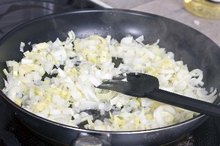What does fact checked mean?
At Healthfully, we strive to deliver objective content that is accurate and up-to-date. Our team periodically reviews articles in order to ensure content quality. The sources cited below consist of evidence from peer-reviewed journals, prominent medical organizations, academic associations, and government data.
- National Institute of Arthritis and Musculoskeletal and Skin Diseases: Questions and Answers About Gout
- U.S. National Library of Medicine: PubMed Health: Gout
- U.S. National Library of Medicine: PubMed Health: Gout
- Linus Pauling Institute Micronutrient Information Center: Vitamin C
The information contained on this site is for informational purposes only, and should not be used as a substitute for the advice of a professional health care provider. Please check with the appropriate physician regarding health questions and concerns. Although we strive to deliver accurate and up-to-date information, no guarantee to that effect is made.
Collard Greens and Gout
Collard greens may be worth considering for health additions to your diet. These dark-green leafy vegetables provide iron, vitamin K, folate, calcium and the antioxidants lutein and zeaxanthin. They may even help you prevent gout or reduce your symptoms when you eat collard greens in moderation as part of a healthy diet.
Gout Background
Gout, or gouty arthritis, is a painful form of arthritis that results from the buildup of uric acid in your joints. Some unmodifiable risk factors for gout include older age, male gender and family history of gout. Some ways to lower your risk for gout are to limit your alcohol consumption to a maximum of one drink per day for women and two drinks for men, to limit sugar and to stay hydrated. Saturated fat raises your risk for gout, so avoid cooking your collard greens in solid fats such as butter or bacon fat.
- Gout, or gouty arthritis, is a painful form of arthritis that results from the buildup of uric acid in your joints.
- Saturated fat raises your risk for gout, so avoid cooking your collard greens in solid fats such as butter or bacon fat.
Low-Purine Diet
Are Radishes Good for Gout?
Learn More
Uric acid is a product that your body makes as part of the process of breaking down purines from food. Your risk for gout may decrease when you choose vegetarian protein sources and limit your intake of animal proteins, which are high-purine foods. Instead of meat, fish, shellfish or poultry, you could eat your collard greens with high-protein plant-based foods such as black-eyed peas or soy-based meat substitutes.
Weight Control
Losing extra weight or maintaining a healthy weight lowers your risk for developing gout. Collard greens can be part of a calorie-controlled diet because each cup has only 49 calories. You can use greens and other low-calorie vegetables as side dishes or add them to soups, stews, casseroles or other recipes to make your meals bigger, and more filling, without adding many calories. Raw, steamed or boiled collard greens are low in calories, but the calories will be higher if you cook your greens in fat, such as butter or oil.
- Losing extra weight or maintaining a healthy weight lowers your risk for developing gout.
- You can use greens and other low-calorie vegetables as side dishes or add them to soups, stews, casseroles or other recipes to make your meals bigger, and more filling, without adding many calories.
Other Nutrients
Foods That Cause Tendonitis
Learn More
A potential benefit of collard greens for gout is their 5.3 grams of dietary fiber per cup, since dietary fiber lowers levels of cholesterol in your blood. High cholesterol is a risk factor for gout. You may also be at risk for gout when your blood pressure is high. Collard greens cooked without salt have only 30 milligrams of sodium per cup, and they provide 220 milligrams of potassium, which is necessary for regulating blood pressure. They have 35 milligrams, or 58 percent of the daily value, of vitamin C, which may lower your risk for gout, according to the Linus Pauling Institute Micronutrient Information Center 3.
- A potential benefit of collard greens for gout is their 5.3 grams of dietary fiber per cup, since dietary fiber lowers levels of cholesterol in your blood.
Related Articles
References
- National Institute of Arthritis and Musculoskeletal and Skin Diseases: Questions and Answers About Gout
- U.S. Department of Health and Human Services: Dietary Guidelines for Americans
- Linus Pauling Institute Micronutrient Information Center: Vitamin C
- Collards, raw. FoodData Central. U.S. Department of Agriculture. Published April 1, 2020.
- National Institutes of Health National Cancer Institute. Cruciferous vegetables and cancer prevention. Updated June 7, 2012.
- Pollock RL. The effect of green leafy and cruciferous vegetable intake on the incidence of cardiovascular disease: A meta-analysis. JRSM Cardiovasc Dis. 2016;5:2048004016661435. doi:10.1177/2048004016661435
- Blekkenhorst LC, Bondonno CP, Lewis JR, et al. Cruciferous and total vegetable intakes are inversely associated with subclinical atherosclerosis in older adult women. J Am Heart Assoc. 2018;7(8). doi:10.1161/JAHA.117.008391
- Anderson JW, Baird P, Davis RH, et al. Health benefits of dietary fiber. Nutr Rev. 2009;67(4):188-205. doi:10.1111/j.1753-4887.2009.00189.x
- Jia YP, Sun L, Yu HS, et al. The pharmacological effects of lutein and zeaxanthin on visual disorders and cognition diseases. Molecules. 2017;22(4). doi:10.3390/molecules22040610
- Scott O, Galicia-Connolly E, Adams D, Surette S, Vohra S, Yager JY. The safety of cruciferous plants in humans: a systematic review. J Biomed Biotechnol. 2012;2012:503241. doi:10.1155/2012/503241
- National Kidney Foundation. Kidney stone diet plan and prevention. Updated June 2019.
- Collards, cooked, from canned, fat not added in cooking. FoodData Central. U.S. Department of Agriculture. Published April 1, 2020.
Resources
Writer Bio
Natalie Stein specializes in weight loss and sports nutrition. She is based in Los Angeles and is an assistant professor with the Program for Public Health at Michigan State University. Stein holds a master of science degree in nutrition and a master of public health degree from Michigan State University.









